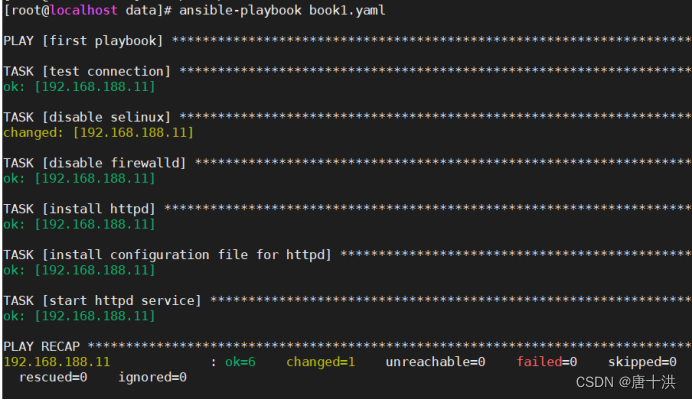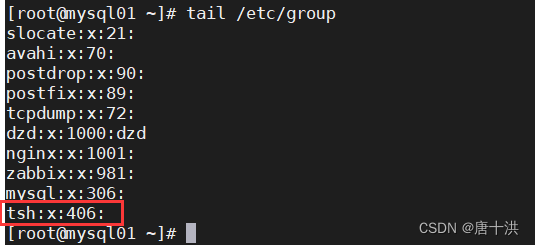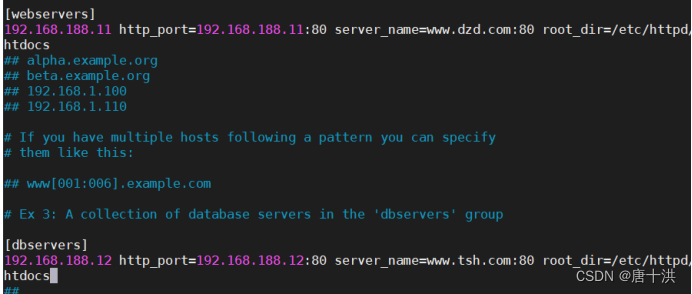Ansible-playbooks案例
playbooks 本身由以下各部分组成
Tasks:任务,即通过 task 调用 ansible 的模板将多个操作组织在一个 playbook 中运行
Variables:变量
Templates:模板
Handlers:处理器,当changed状态条件满足时,(notify)触发执行的操作
Roles:角色
实验前准备
Ansible服务器:192.168.188.17 安装ansible
待管理主机1:192.168.188.11 webservers组
待管理主机2:192.168.188.12 dbservers组
示例
安装httpd服务并启动
vim book1.yaml
---
- name: first playbook
gather_facts: false
hosts: webservers
remote_user: root
tasks:
- name: test connection
ping:
- name: disable selinux
command: '/sbin/setenforce 0'
ignore_errors: True
- name: disable firewalld
service: name=firewalld state=stopped
- name: install httpd
yum: name=httpd state=latest
- name: install configuration file for httpd
copy: src=/opt/httpd.conf dest=/etc/httpd/conf/httpd.conf
notify: "restart httpd"
- name: start httpd service
service: enabled=true name=httpd state=started
handlers:
- name: restart httpd
service: name=httpd state=restarted
解释如下:
--- #yaml文件以---开头,以表明这是一个yaml文件,可省略
- name: first play #定义一个play的名称,可省略
gather_facts: false #设置不进行facts信息收集,这可以加快执行速度,可省略
hosts: webservers #指定要执行任务的被管理主机组,如多个主机组用冒号分隔
remote_user: root #指定被管理主机上执行任务的用户
tasks: #定义任务列表,任务列表中的各任务按次序逐个在hosts中指定的主机上执行
- name: test connection #自定义任务名称
ping: #使用 module: [options] 格式来定义一个任务
- name: disable selinux
command: '/sbin/setenforce 0' #command模块和shell模块无需使用key=value格式
ignore_errors: True #如执行命令的返回值不为0,就会报错,tasks停止,可使用ignore_errors忽略失败的任务
- name: disable firewalld
service: name=firewalld state=stopped #使用 module: options 格式来定义任务,option使用key=value格式
- name: install httpd
yum: name=httpd state=latest
- name: install configuration file for httpd
copy: src=/opt/httpd.conf dest=/etc/httpd/conf/httpd.conf #这里需要一个事先准备好的/opt/httpd.conf文件
notify: "restart httpd" #如以上操作后为changed的状态时,会通过notify指定的名称触发对应名称的handlers操作
- name: start httpd service
service: enabled=true name=httpd state=started
handlers: #handlers中定义的就是任务,此处handlers中的任务使用的是service模块
- name: restart httpd #notify和handlers中任务的名称必须一致
service: name=httpd state=restarted
##Ansible在执行完某个任务之后并不会立即去执行对应的handler,而是在当前play中所有普通任务都执行完后再去执行handler,这样的好处是可以多次触发notify,但最后只执行一次对应的handler,从而避免多次重启。
运行剧本
别忘了先在ansible服务器上准备一个/opt/httpd.conf
直接复制现成的用就行,没有就yum安装一个httpd
cp /etc/httpd/conf/httpd.conf /opt/httpd.conf
正式运行
ansible-playbook book1.yaml
成功就是下面那样

补充参数:
-k(–ask-pass):用来交互输入ssh密码
-K(-ask-become-pass):用来交互输入sudo密码
-u:指定用户
ansible-playbook test1.yaml --syntax-check #检查yaml文件的语法是否正确
ansible-playbook test1.yaml --list-task #检查tasks任务
ansible-playbook test1.yaml --list-hosts #检查生效的主机
ansible-playbook test1.yaml --start-at-task=‘install httpd’ #指定从某个task开始运行
定义、引用变量
vim book1.yaml
直接接在之前的first playbook内容后面写也行,再写一个yaml文件也可以
- name: second playbook
hosts: dbservers
remote_user: root
vars:
- groupname: testgroup
- username: testuser
tasks:
- name: create group
group: name={{groupname}} system=yes gid=406
- name: create user
user: name={{username}} uid=406 group={{groupname}}
- name: copy file
copy: content="{{ansible_default_ipv4}}" dest=/opt/vars.txt
部分解释如下:
- name: second play
hosts: dbservers
remote_user: root
vars: #定义变量
- groupname: mysql #格式为 key: value
- username: nginx
tasks:
- name: create group
group: name={{groupname}} system=yes gid=306 #使用 {{key}} 引用变量的值
- name: create user
user: name={{username}} uid=306 group={{groupname}} #在setup模块中可以获取factsup={{groupname}}
- name: copy file变量信息
copy: content="{{ansible_default_ipv4}}" dest=/opt/vars.txt
运行时在命令行里定义变量
ansible-playbook book1.yaml -e “groupname=tsh”
先看运行有没有成功

然后看一下创建的组到底是yaml文件里的testgroup还是我们在命令行里输入的tsh
去主机2(dbservers中的主机192.168.188.12)看
tail /etc/group

再来看下用户
tail /etc/passwd

指定主机sudo切换用户
vim book2.yaml
---
- hosts: dbservers
remote_user: dzd
become: yes
become_user: root
解释如下:
- hosts: dbservers
remote_user: zhangsan
become: yes #2.6版本以后的参数,之前是sudo,意思为切换用户运行
become_user: root #指定sudo用户为root
运行playbook
ansible-playbook book2.yaml -K
然后输入密码
when条件判断
在Ansible中,提供的唯一一个通用的条件判断是when指令,当when指令的值为true时,则该任务执行,否则不执行该任务
when一个比较常见的应用场景是实现跳过某个主机不执行任务或者只有满足条件的主机执行任务
vim book3.yaml
这个剧本的意思是当主机IP为192.168.188.11时执行重启任务
---
- hosts: all
remote_user: root
tasks:
- name: shutdown host
command: /sbin/shutdown -r now
when: ansible_default_ipv4.address == "192.168.188.11"
运行
ansible-playbook book3.yaml
迭代
Ansible提供了很多种循环结构,一般都命名为with_items,作用等同于 loop 循环
vim book4.yaml
---
- name: playbook4
hosts: dbservers
gather_facts: false
tasks:
- name: create directories
file:
path: "{{item}}"
state: directory
with_items:
- /tmp/test1
- /tmp/test2
- name: add users
user: name={{item.name}} state=present groups={{item.groups}}
with_items:
- name: test1
groups: wheel
- name: test2
groups: root
运行
ansible-playbook book4.yaml
看一下dbservers上的/tmp目录下是否有这两个目录

Templates模块
Jinja是基于Python的模板引擎。Template类是Jinja的一个重要组件,可以看作是一个编译过的模板文件,用来产生目标文本,传递Python的变量给模板去替换模板中的标记
准备模板
先准备一个以 .j2 为后缀的 template 模板文件,设置引用的变量
cp /etc/httpd/conf/httpd.conf /opt/httpd.conf.j2
修改模板,主要就是把一些可能需要改的值设置为变量,比如说:
端口

服务器名

文件目录

修改主机清单
vim /etc/ansible/hosts
在这里相当于给所需的变量赋值

编写剧本
vim apache.yaml
---
- hosts: all
remote_user: root
vars:
- package: httpd
- service: httpd
tasks:
- name: install httpd package
yum: name={{package}} state=latest
- name: install configure file
template: src=/opt/httpd.conf.j2 dest=/etc/httpd/conf/httpd.conf
notify:
- restart httpd
- name: create root dir
file: path=/etc/httpd/htdocs state=directory
- name: start httpd server
service: name={{service}} enabled=true state=started
handlers:
- name: restart httpd
service: name={{service}} state=restarted
运行剧本
ansible-playbook apache.yaml

tags模块
可以在一个playbook中为某个或某些任务定义“标签”,在执行此playbook时通过ansible-playbook命令使用–tags选项能实现仅运行指定的tasks
playbook还提供了一个特殊的tags为always。作用就是当使用always当tags的task时,无论执行哪一个tags时,定义有always的tags都会执行
vim hosts.yaml
这个剧本中的dbservers和webservers两部分只有touch file任务的tags有区别,webservers的touch file任务有always标签,理论上来说会永远执行,而dbservers不会
---
- hosts: webservers
remote_user: root
tasks:
- name: Copy hosts file
copy: src=/etc/hosts dest=/opt/hosts
tags:
- only
- name: touch file
file: path=/opt/testhost state=touch
tags:
- always
- hosts: dbservers
remote_user: root
tasks:
- name: Copy hosts file
copy: src=/etc/hosts dest=/opt/hosts
tags:
- only
- name: touch file
file: path=/opt/testhost state=touch
运行
ansible-playbook hosts.yaml --tags=“only”
执行完毕去两台主机上看一下
webservers:
带有only标签而创建的hosts文件和带有always标签而创建的testhost都有

dbservers:
只有带有only标签而创建的hosts文件,说明没有标签的touch file任务没有执行

本文来自互联网用户投稿,该文观点仅代表作者本人,不代表本站立场。本站仅提供信息存储空间服务,不拥有所有权,不承担相关法律责任。 如若内容造成侵权/违法违规/事实不符,请联系我的编程经验分享网邮箱:chenni525@qq.com进行投诉反馈,一经查实,立即删除!